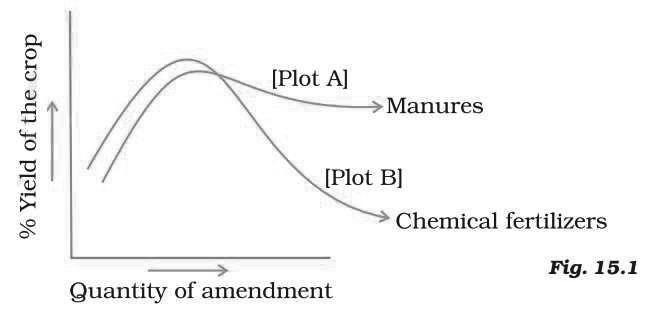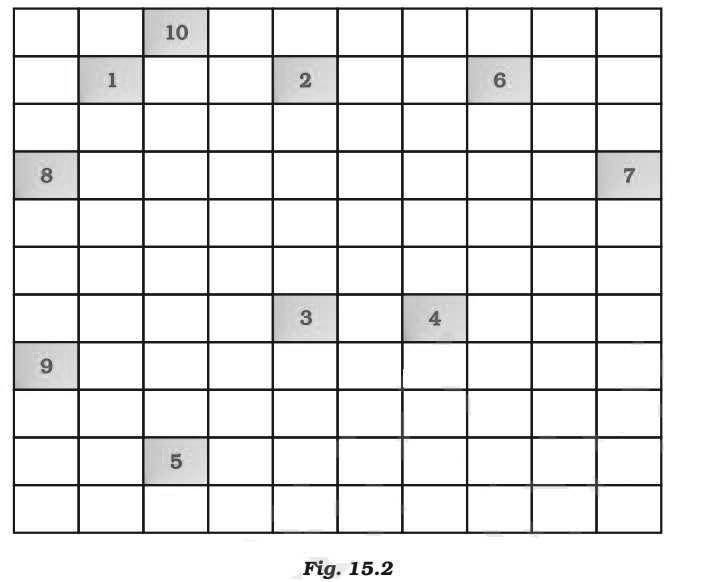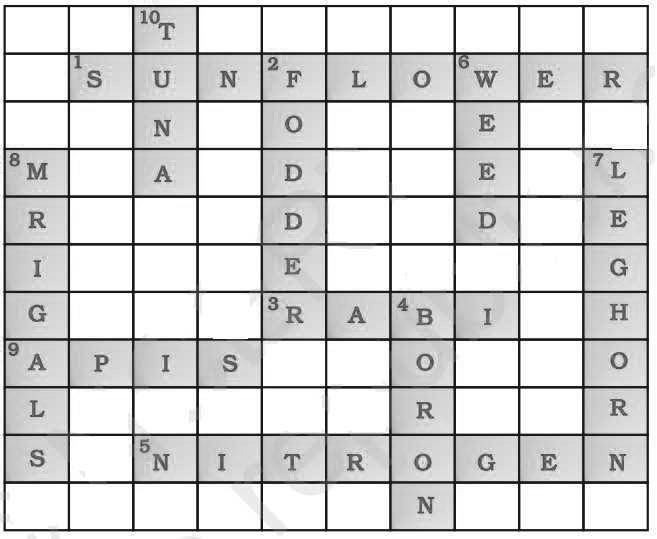Read and download free pdf of CBSE Class 9 Biology Improvement In Food Resources Worksheet Set C . Students and teachers of Class 9 Science can get free printable Worksheets for Class 9 Science Chapter 12 Improvement in Food Resources in PDF format prepared as per the latest syllabus and examination pattern in your schools. Class 9 students should practice questions and answers given here for Science in Class 9 which will help them to improve your knowledge of all important chapters and its topics. Students should also download free pdf of Class 9 Science Worksheets prepared by teachers as per the latest Science books and syllabus issued this academic year and solve important problems with solutions on daily basis to get more score in school exams and tests
Worksheet for Class 9 Science Chapter 12 Improvement in Food Resources
Class 9 Science students should download to the following Chapter 12 Improvement in Food Resources Class 9 worksheet in PDF. This test paper with questions and answers for Class 9 will be very useful for exams and help you to score good marks
Class 9 Science Worksheet for Chapter 12 Improvement in Food Resources
Question: Give one word for the following
Question: Growing different crops on a piece of land in pre-planned succession is known as __________.
Answer: crop rotation
Question: Farming without the use of chemicals as fertilizers, herbicides and pesticides is known as __________.
Answer: organic farming
Question: Xanthium and Parthenium are commonly known as __________.
Answer: weeds
Question: Causal organism of any disease is called as __________.
Answer: pathogen
Question: Growing of wheat and groundnut on the same field is called as __________.
Answer: mixed cropping
Question: Planting soyabean and maize in alternate rows in the same field is called as __________.
Answer: inter cropping
Question: Match the column A with the column B

Answer: a)— (ii) b)— (iii) c)— (i) d)— (iv)
Question: What is a GM crop? Name any one such crop which is grown in India.
Answer: Crop which has been developed by introducing a new gene from any other source, to obtain the desired character, is called as genetically modified (GM) crop. But Cotton is an example of GM crop which is made insect resistant by introducing a new gene from a bacteria.
Question: List out some useful traits in improved crop?
Answer: Useful traits of improved crops are
a) higher yield
b) improved nutritional quality
c) resistance to biotic and abiotic stresses
d) change in maturity
e) wide range of adaptability
f) desired agronomic characteristics.
Question: Why is excess use of fertilizers detrimental for environment?
Answer: Excess use of fertilizers causes environmental pollution as their residual and unused amounts will become pollutants for air, water and soil.
Question: Match the following A and B

Answer: a)—(iii) b)—(v) c)—(iv) d)—(i) (e)—(ii)
Question: Group the following and tabulate them as energy yielding, protein yielding, oil yielding and fodder crop.
Wheat, rice, berseem, maize, gram, oat, pigeon gram, sudan grass, lentil, soyabean, groundnut, castor and mustard.
Answer: (1) Energy yielding— wheat, rice, maize
(2) Protein yielding— gram, pigeon gram, lentil, soybean
(3) Oil yielding— groundnut, castor, mustard, soybean
(4) Fodder crops— barseem, oat, sudan grass
Question: Define the term hybridization and photoperiod.
Answer: Hybridization— Hybridization refers to crossing between genetically dissimilar organisms.
Photoperiod— Duration of sunlight available to the plant is called as photoperiod. It affects the growth, flowering and maturation of crops.
Question: Cultivation practices and crop yield are related to environmental condition. Explain.
Answer: Different crops and cultivation practices require different climatic conditions, temperature, photoperiod for their growth and completion of life cycle. There are some crops which are grown in rainy season (Kharif crops) while some others are grown during winter season (Rabi crops).
Question: Differentiate between compost and vermicompost?
Answer: Compost— Compost formation is the process in which farm waste materials like livestock excreta, vegetable wastes, animal refuse, domestic waste, straw, eradicated weeds are decomposed and used as manure.
Vermicompost— The compost prepared from organic matter by using earthworm which hastens the process of decomposition.
Question: Discuss the role of hybridisation in crop improvement.
Answer: Hybridisation refers to crossing between genetically dissimilar plants. It may be inter varietel, inter specific and inter generic. Two crops of good characters (desired character) are selected and crossed to obtain a new crop having desired characters of parental crops. This method of hybridisation improves crops with respect to yield, disease resistance, pest resistance etc.
Question: Arrange these statements in correct sequence of preparation of green manure.
a) Green plants are decomposed in soil.
b) Green plants are cultivated for preparing manure or crop plant parts are used.
c) Plants are ploughed and mixed into the soil.
d) After decomposition it becomes green manure.
Answer: b) →c) →a) →d)
Question: In agricultural practices, higher input gives higher yield. Discuss how?
Answer: In agricultural practices, higher input gives higher yield. This means higher money input to raise the yield. Financial conditions of the farmers allows them to take up different farming practices and technologies. The farmer’s purchasing capacity for input decides cropping system and production practices.
Question: Why is organic matter important for crop production?
Answer: Organic matter is important for crops because
a) it helps in improving soil structure.
b) it helps in increasing water holding capacity of sandy soil.
c) in clayey soil large quantity of organic matter helps in drainage and in avoiding water logging.
Question: Define
(i) Vermicompost
(ii) Green manure
(iii) Bio fertilizer
Answer: a) Vermicompost— Compost is a kind of manure which is rich in organic matter and nutrients. The compost prepared by using earthworms to hasten the process of decomposition of plants and animals refuse is called as Vermicompost.
b) Green manure— The manure which is prepared by decomposing green plants in field itself is called green manure. For example — sun hemp is grown in fields, mulched by ploughing and allowed to decompose in field for the preparation of green manure.
c) Bio fertilizer— Living organisms which are used as fertilizer to supply the nutrients to plants, are called as biofertilizers. For example, blue green algae, which fix nitrogen in soil, rice fields, are called as biofertilizer.
Question: An Italian bee variety A. mellifera has been introduced in India for honey production. Write about its merits over other varieties.
Answer: Merits of Italian bee variety A. mellifera are—
a) It stings less.
b) It has high honey collection capacity.
c) It stays in given bee-hive for long periods and breeds very well.
Question: Why bee keeping should be done in good pasturage?
Answer: Bees need nectar to make honey. A good pasturage con provided plenty of flowers with good quality nectar. This will help the bees in making good quality honey; in larger quantity. Thus, a good pasturage will help in improving honey yield. Moreover, if bees are confined in order to utilize nectar only from a particular variety of flower, the taste, colour and consistency of honey will be entirely unique. Many beekeepers make honey prepared from nectar from a particular variety of flower only.
Question: Differentiate between the following
(i) Capture fishery and Culture fishery
(ii) Mixed cropping and Inter cropping
(iii) Bee keeping and Poultry farming
Answer: a) Capture fishery is the method of obtaining fish from natural resources while culture fishery is the method of obtaining fish by fish farming.
b) Mixed cropping is growing two or more crops simultaneously on the same piece of land; while intercropping is growing two or more crops simultaneously on the same field in a definite pattern. i.e., in different rows.
c) Bee keeping is the practice to rear the honey bee for obtaining honey; while poultry farming is the practice to raise the domestic fowl for egg and meat production.
Question: Give the merits and demerits of fish culture?
Answer: Demerits (i) threat to bio-diversity (ii) only economically important and valued fishes will be cultured. Merits (i) large amount of desired fishes can be obtained in small area (ii) improvement can be done.
Question: Suggest some preventive measures for the diseases of poultry birds.
Answer: Some preventive measures of poultry bird diseases are
a) cleaning of poultry farms
b) proper sanitation of poultry farms
c) spraying of disinfectants at regular intervals
d) appropriate vaccination of birds.
Question: What do you understand by composite fish culture?
Answer: Composite fish culture is the method to culture five or six species, both indegenous and exotic, together in a single fish pond. These species are selected so that they do not compete for food among themselves having different types of food habits. As a result food available in all the parts of the pond is used. For example— Catlas are surface feeders, Rohu is middle zone feeder and Mrigals and common carps are bottom feeders.
Question: Discuss various methods for weed control.
Answer: Various modes of weed control are
a) mechanical removal
b) proper seed bed preparation to avoid the weed growth
c) timely sowing of crop to avoid the growth of weed.
d) intercropping and crop rotation also help in weed control.
Question: If there is low rainfall in a village throughout the year, what measures will you suggest to the farmers for better cropping?
Answer: Farmers of low rainfall area will be suggested to
a) practice farming with drought resistant and early maturing varieties of crops.
b) to enrich the soil with more humus content as it increases the water holding capacity and retains water for longer duration.
Question: Write the modes by which insects affect the crop yield.
Answer: Following are the different modes by which insect pests affect the crop yield.
(i) Cutting: Some insect pests cut different plant parts; like leaves, fruits and flowers. Thus, they damage the plant. Damaged leaves would result in lower rate of photosynthesis. Damaged flowers will result in less production of seeds.
(ii) Borers: Some pests make a burrow in a plant part and live inside. There can be stem borers or fruit borers. These pests utilize resources from plants.
(iii) Suckers: Some pests use their proboscis to suck cell sap from plant parts.
Question: Name two types of animal feed and write their functions.
Answer: Two types of animal feed are as follows:
Roughage: Roughage makes the bulk of animal feed. Roughage helps the animal in getting satiated. Roughage also helps in proper digestion of food. Roughage is provided by husk and hay and also by grass and chopped leaves.
Concentrates: Concentrates are rich in proteins and minerals. Concentrate are specially prepared according to the requirement of a particular cattle. Concentrates are also available in market.
Question: What would happen if poultry birds are larger in size and have no summer adaptation capacity? In order to get small sized poultry birds, having summer adaptability, what method will be employed?
Answer: Maintenance of temperature is needed for better egg production by poultry birds. Therefore, larger size (increase in surface area of body) and no adaptability of summer may cause decline in egg production. To obtain the smaller size and higher summer adaptability, cross breeding of poultry birds are done. Small size is also needed for better housing and low feed.
Question: Figure 15.1 shows the two crop fields [Plots A and B] have been treated by manures and chemical fertilizers respectively, keeping other environmental factors same. Observe the graph and answer the following questions.

(i) Why does plot B show sudden increase and then gradual decrease in yield?
(ii) Why is the highest peak in plot A graph slightly delayed?
(iii) What is the reason for the different pattern of the two graphs?
Answer: (i) With addition of chemical fertilizer there is sudden increase in yield due to release of nutrients N,P,K etc in high quantity. The gradual decline in the graph may be due to continuous use and high quantity of chemicals which kills microbes useful for replenishing the organic matter in the soil. This decreases the soil fertility.
(ii) Manures supply small quantities of nutrients to the soil slowly as it contains large amounts of organic matter [Hint: importance of organic matter can be included]. It enriches soil with nutrients thereby increasing soil fertility continuously.
(iii) The difference in the two graphs indicate that use of manure is beneficial for long duration in cropping as the yield tends to remain high when the quantity of manure increases. In case of Plot B the chemical fertilizers may cause various problems when used continuously for long time. Loss of microbial activity reduces decomposition of organic matter and as a result soil fertility is lost that affects the yield.
Question: Discuss why pesticides are used in very accurate concentration and in very appropriate manner?
Answer: Pesticides are used in very accurate concentration and in a very appropriate manner, because if used in excess it
a) harms the soil and causes loss of fertility
b) checks the replenishment of organic matter
c) kills the micro-organism of soil
d) causes air, water and soil pollution.
Question: Complete the crossword puzzle (Fig.15.2) Across

1. Oil yielding plant (9)
3. Crop grown in winter season (4)
5. Fixed by Rhizobium (8)
9. Common honey bee (4)
Downward
2. Animal feed (6)
4. A micronutrient (5)
6. Unwanted plant in crop fields (4)
7. An exotic breed of chicken (7)
8. Bottom feeders in fish pond (7)
10. A marine fish (4)
Answer: Crossword.

| CBSE Class 9 Chemistry Matter In Our Surrounding Worksheet Set A |
| CBSE Class 9 Chemistry Matter In Our Surrounding Worksheet Set B |
| CBSE Class 9 Chemistry Is Matter Around Us Pure Worksheet Set A |
| CBSE Class 9 Chemistry Is Matter Around Us Pure Worksheet Set B |
| CBSE Class 9 Physics Motion Worksheet Set A |
| CBSE Class 9 Physics Motion Worksheet Set B |
| CBSE Class 9 Physics Gravitation Worksheet Set A |
| CBSE Class 9 Physics Gravitation Worksheet Set B |
| CBSE Class 9 Physics Work And Energy Worksheet Set A |
| CBSE Class 9 Physics Work And Energy Worksheet Set B |
| CBSE Class 9 Physics Sound Worksheet Set A |
| CBSE Class 9 Physics Sound Worksheet Set B |
| CBSE Class 9 Physics Sound Worksheet Set C |
| CBSE Class 9 Biology Why Do We Fall Ill Worksheet Set A |
| CBSE Class 9 Biology Why Do We Fall Ill Worksheet Set B |
| CBSE Class 9 Biology Why Do We Fall Ill Worksheet Set C |
| CBSE Class 9 Biology Natural Resources Worksheet Set A |
| CBSE Class 9 Biology Natural Resources Worksheet Set B |
| CBSE Class 9 Biology Natural Resources Worksheet Set C |
Worksheet for CBSE Science Class 9 Chapter 12 Improvement in Food Resources
We hope students liked the above worksheet for Chapter 12 Improvement in Food Resources designed as per the latest syllabus for Class 9 Science released by CBSE. Students of Class 9 should download in Pdf format and practice the questions and solutions given in the above worksheet for Class 9 Science on a daily basis. All the latest worksheets with answers have been developed for Science by referring to the most important and regularly asked topics that the students should learn and practice to get better scores in their class tests and examinations. Expert teachers of studiestoday have referred to the NCERT book for Class 9 Science to develop the Science Class 9 worksheet. After solving the questions given in the worksheet which have been developed as per the latest course books also refer to the NCERT solutions for Class 9 Science designed by our teachers. We have also provided a lot of MCQ questions for Class 9 Science in the worksheet so that you can solve questions relating to all topics given in each chapter.
You can download the CBSE Printable worksheets for Class 9 Science Chapter 12 Improvement in Food Resources for latest session from StudiesToday.com
There is no charge for the Printable worksheets for Class 9 CBSE Science Chapter 12 Improvement in Food Resources you can download everything free
Yes, studiestoday.com provides all latest NCERT Chapter 12 Improvement in Food Resources Class 9 Science test sheets with answers based on the latest books for the current academic session
CBSE Class 9 Science Chapter 12 Improvement in Food Resources worksheets cover all topics as per the latest syllabus for current academic year.
Regular practice with Class 9 Science worksheets can help you understand all concepts better, you can identify weak areas, and improve your speed and accuracy.

